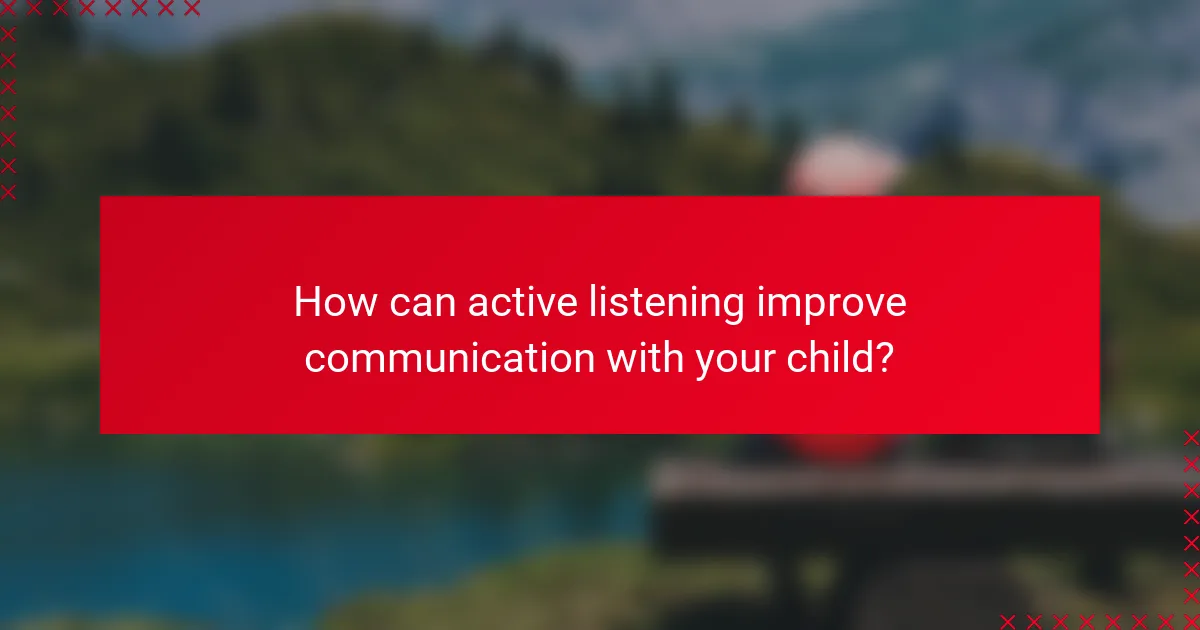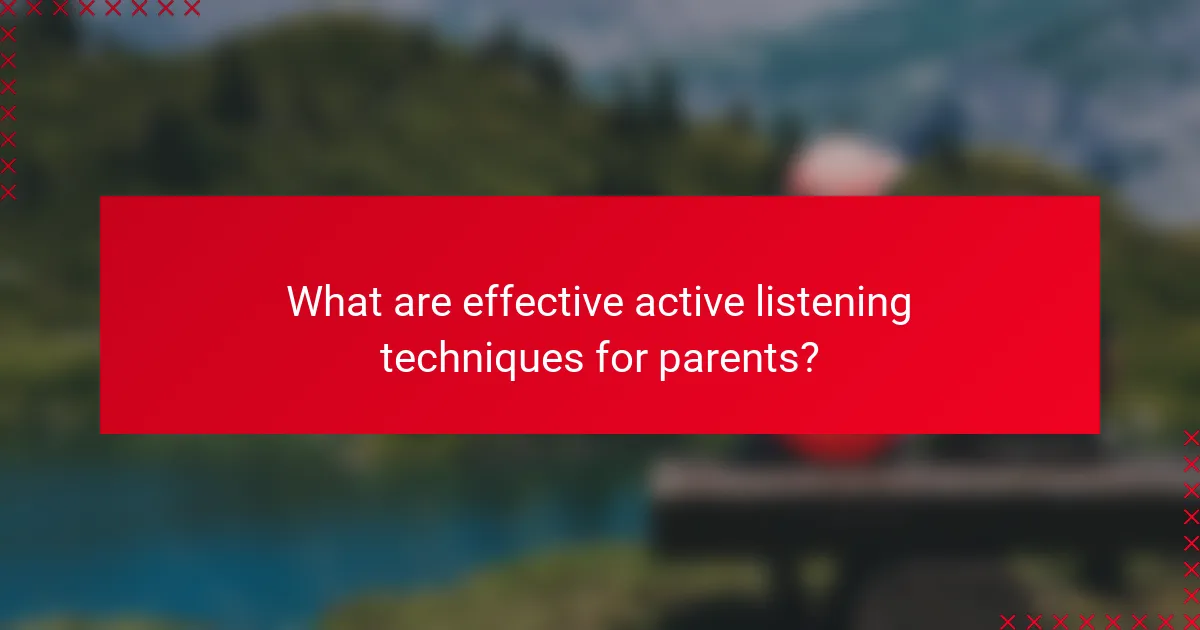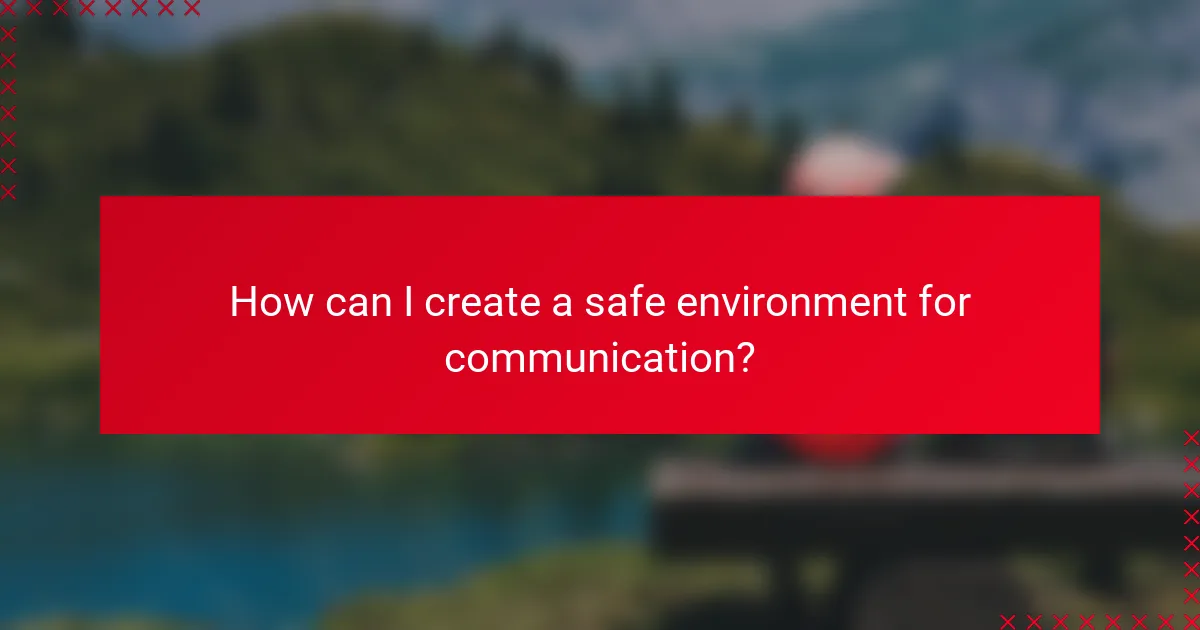Active listening is a crucial skill for parents aiming to enhance communication with their children. By fully concentrating on what your child is expressing, you not only make them feel valued but also create a supportive environment that encourages open dialogue. Implementing effective active listening techniques can significantly strengthen your relationship and foster deeper understanding.

How can active listening improve communication with your child?
Active listening can significantly enhance communication with your child by fostering understanding and connection. It involves fully concentrating on what your child is saying, which helps them feel valued and encourages more effective exchanges.
Enhances emotional connection
Active listening strengthens the emotional bond between you and your child. When you listen attentively, your child feels heard and understood, which can lead to deeper feelings of safety and security in your relationship.
For example, when your child shares their feelings about a tough day at school, reflecting back their emotions shows that you care. This practice can transform a simple conversation into a meaningful connection.
Encourages open dialogue
By practicing active listening, you create an environment where your child feels comfortable expressing their thoughts and feelings. This openness can lead to more honest conversations and a willingness to share concerns or joys.
To encourage open dialogue, ask open-ended questions and give your child time to respond without interruption. This approach allows them to articulate their thoughts fully and fosters a culture of communication.
Builds trust and respect
Active listening is fundamental in building trust and respect between you and your child. When children see that their opinions matter, they are more likely to trust your guidance and respect your viewpoints.
To build this trust, consistently practice active listening during conversations, even when discussing difficult topics. This consistency reinforces the idea that you value their input, which can lead to a stronger, more respectful relationship.

What are effective active listening techniques for parents?
Effective active listening techniques for parents include methods that enhance communication and understanding with their children. These techniques foster a supportive environment where children feel heard and valued, encouraging open dialogue.
Reflective listening
Reflective listening involves mirroring back what your child has said to confirm understanding. This technique helps children feel acknowledged and can clarify any misunderstandings. For example, if your child expresses frustration about school, you might respond with, “It sounds like you’re feeling overwhelmed by your homework.”
To practice reflective listening, maintain eye contact and use affirmative body language. Avoid interrupting, and wait for your child to finish speaking before responding. This shows that you are fully engaged in the conversation.
Paraphrasing child’s words
Paraphrasing involves restating your child’s words in your own language to show comprehension. This technique not only confirms that you are listening but also encourages your child to elaborate on their thoughts. For instance, if your child says, “I don’t like going to soccer practice,” you might reply, “So, you’re not enjoying soccer as much as you used to.”
When paraphrasing, keep it concise and focus on the main idea. This helps your child feel understood and can prompt them to share more about their feelings or experiences. Avoid adding your opinions at this stage to keep the focus on their perspective.
Asking open-ended questions
Open-ended questions encourage children to express themselves more freely and provide deeper insights into their thoughts and feelings. Instead of asking yes-or-no questions, try to frame inquiries that require more elaborate responses. For example, instead of asking, “Did you have a good day?” consider asking, “What was the best part of your day?”
Using open-ended questions can lead to richer conversations and help children develop their communication skills. Aim to ask questions that start with “how,” “what,” or “why” to promote discussion. Be patient and give your child time to think and respond fully.

How can I practice active listening in everyday conversations?
Practicing active listening in everyday conversations involves fully engaging with your child by focusing on their words, emotions, and non-verbal cues. This technique fosters better communication and strengthens your relationship by showing that you value their thoughts and feelings.
Minimize distractions
To effectively practice active listening, minimize distractions in your environment. Turn off the television, put away your phone, and choose a quiet space where you can focus solely on your child. This shows them that they have your full attention.
Consider setting aside specific times for conversations, such as during meals or before bedtime, when distractions are naturally lower. This routine can help both you and your child feel more connected and engaged.
Maintain eye contact
Maintaining eye contact is crucial for active listening as it conveys interest and attentiveness. When you look directly at your child while they speak, it encourages them to express themselves more openly. Aim for natural eye contact, avoiding a stare that might make them uncomfortable.
Try to match their eye level by kneeling or sitting down if they are smaller. This physical alignment can enhance the connection and make your child feel more valued during the conversation.
Use affirming body language
Using affirming body language reinforces your engagement in the conversation. Nodding, leaning slightly forward, and using open gestures can signal to your child that you are listening and understanding. These non-verbal cues are just as important as verbal responses.
Be mindful of your facial expressions as well; a warm smile or an empathetic frown can help convey your emotional support. Avoid crossing your arms or looking away, as these actions may suggest disinterest or impatience.

What role does empathy play in active listening?
Empathy is crucial in active listening as it enables parents to connect with their child’s emotions and perspectives. By genuinely understanding what a child feels, parents can respond more effectively and foster a trusting relationship.
Fosters understanding
Empathy enhances understanding by allowing parents to see situations from their child’s viewpoint. This perspective-taking helps clarify the child’s thoughts and feelings, leading to more meaningful conversations. For instance, when a child expresses frustration about school, a parent who empathizes can ask questions that reveal underlying issues, such as social challenges or academic pressure.
To promote understanding, parents can practice reflective listening, where they paraphrase what the child has said. This technique not only confirms that the parent is engaged but also encourages the child to elaborate further, deepening the dialogue.
Validates child’s feelings
Validating a child’s feelings is essential for their emotional development. When parents acknowledge their child’s emotions, it reassures the child that their feelings are legitimate and important. For example, saying “I can see that you’re really upset about this” helps the child feel heard and supported.
To effectively validate feelings, parents should avoid dismissive phrases like “It’s not a big deal” or “You’ll get over it.” Instead, they should focus on empathetic responses that encourage open communication. Simple affirmations like “It’s okay to feel that way” can create a safe space for children to express themselves freely.

How can I create a safe environment for communication?
Creating a safe environment for communication involves fostering trust and openness, allowing your child to express themselves freely. This can be achieved through consistent practices that encourage dialogue and understanding.
Establish regular check-ins
Regular check-ins provide a structured opportunity for your child to share their thoughts and feelings. Aim for weekly or bi-weekly sessions where you can discuss their experiences, concerns, and achievements in a relaxed setting.
During these check-ins, use open-ended questions to invite deeper conversation. For example, ask, “What was the best part of your week?” or “Is there anything bothering you lately?” This approach helps children feel valued and heard.
Encourage sharing without judgment
To promote open communication, ensure your child knows that sharing their thoughts will not lead to criticism or punishment. Create a non-judgmental atmosphere where they feel safe expressing their feelings, even if they differ from your own.
Reinforce this by actively listening and validating their emotions. Phrases like “I understand why you feel that way” can help them feel accepted. Avoid interrupting or offering immediate solutions; instead, focus on understanding their perspective first.

What are common barriers to active listening?
Common barriers to active listening include preconceived notions, distractions from technology, and emotional triggers. These obstacles can hinder effective communication, especially when engaging with children, making it essential to recognize and address them.
Preconceived notions
Preconceived notions can significantly obstruct active listening by causing you to make assumptions about what your child is saying. When you enter a conversation with biases or judgments, you may overlook important details or dismiss their feelings. To combat this, approach each discussion with an open mind and a willingness to understand their perspective.
For example, if you believe your child is simply seeking attention, you might miss the underlying issues they are trying to express. Practice active listening by asking clarifying questions and reflecting on their words without jumping to conclusions.
Distractions from technology
Technology can create significant distractions that impede active listening. Notifications from phones, tablets, or computers can divert your attention away from your child, making it difficult to engage fully in the conversation. To enhance communication, consider setting aside devices during discussions to foster a more focused environment.
Establishing tech-free zones or times, such as during family meals or designated talk times, can help minimize these distractions. This practice encourages deeper connections and allows for more meaningful exchanges.
Emotional triggers
Emotional triggers can derail active listening by causing strong reactions that cloud judgment. When a child brings up sensitive topics, you may feel defensive or upset, which can prevent you from hearing their message clearly. Recognizing your emotional triggers is crucial for maintaining composure during discussions.
To manage emotional responses, take a moment to breathe and center yourself before responding. Acknowledge your feelings but prioritize your child’s need to communicate. This approach not only improves listening but also models emotional regulation for your child.

How can I measure the effectiveness of my active listening?
To measure the effectiveness of your active listening, observe your child’s responses and engagement during conversations. Look for signs of understanding, such as asking questions or providing feedback, which indicate that they feel heard and valued.
Feedback from your child
One of the most direct ways to gauge your active listening skills is through feedback from your child. Encourage them to express how they feel about your conversations. Ask open-ended questions like, “Do you feel like I understand you?” or “What could I do better when we talk?”
Pay attention to their verbal and non-verbal cues. If they maintain eye contact, nod, or lean in while speaking, these are positive signs that they feel engaged. Conversely, if they seem distracted or disinterested, it may indicate that your listening skills need improvement.
Consider keeping a simple checklist of effective listening behaviors, such as summarizing what your child says, asking clarifying questions, and avoiding interruptions. Regularly review this checklist with your child to identify areas for growth and celebrate improvements together.
